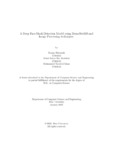| dc.contributor.advisor | Uddin, Jia | |
| dc.contributor.advisor | Reza, Md. Tanzim | |
| dc.contributor.author | Bhowmik, Durjoy | |
| dc.contributor.author | Abdullah, Mohd.Rahat Bin | |
| dc.contributor.author | Islam, Mohammed Tanvirul | |
| dc.date.accessioned | 2022-03-03T03:53:57Z | |
| dc.date.available | 2022-03-03T03:53:57Z | |
| dc.date.copyright | 2022 | |
| dc.date.issued | 2022-01 | |
| dc.identifier.other | ID 17301153 | |
| dc.identifier.other | ID 17301215 | |
| dc.identifier.other | ID 17301056 | |
| dc.identifier.uri | http://hdl.handle.net/10361/16380 | |
| dc.description | This thesis is submitted in partial fulfillment of the requirements for the degree of Bachelor of Science in Computer Science and Engineering, 2022. | en_US |
| dc.description | Cataloged from PDF version of thesis. | |
| dc.description | Includes bibliographical references (pages 39-41). | |
| dc.description.abstract | The world stood still during the massive breakout of the Covid-19 worldwide. This
massive outbreak of this contagious disease was occurred by being airborne. Not
only COVID but also there are many other contagious disease which spread through
air. So at present time, mask has become an essential part of our life which protects
us from being affected from getting affected by COVID along with small diseases like
cold, flu etc. We can get rid of these diseases and stop them from spreading just by
wearing a face mask properly. In our research we would propose a way to identify or
detect weather a person is using a face mask properly or not. For this we have used
image data. The dataset that we have use are being made by us. Which consists
of 1,45,537 images. We have divided this dataset into three segments. Which are
with mask, without mask and misplaced mask. Among them 1,45,537 number are of
images are of Asian region and rest is of the other countries. The main idea was to
detect masked face properly using Deep learning architecture. We have implemented
DenseNet169 and VGG19 to train the model and test it on images and videos. The
accuracy that we got by using DenseNet169 is 91.47% in color images and 88.83%
in grayscale. On the other hand in VGG19 we have got accuracy of 88.52% in color
images and 92.4% in grayscale. Which makes this model more reliable than the rest.
When we implemented this on video we got accuracy of 75.36% in DenseNet169. On
the other hand, in VGG19 we have got 92.30% from gray scale. We have tried to
provide a brief understanding of this architecture along with statistical results that
we got from our dataset with a view to identify a person wearing mask properly
or not. In addition it can identify the persons without wearing mask or persons
wearing mask improperly. | en_US |
| dc.description.statementofresponsibility | Durjoy Bhowmik | |
| dc.description.statementofresponsibility | Mohd.Rahat Bin Abdullah | |
| dc.description.statementofresponsibility | Mohammed Tanvirul Islam | |
| dc.format.extent | 41 pages | |
| dc.language.iso | en | en_US |
| dc.publisher | Brac University | en_US |
| dc.rights | Brac University theses are protected by copyright. They may be viewed from this source for any purpose, but reproduction or distribution in any format is prohibited without written permission. | |
| dc.subject | Covid-19 | en_US |
| dc.subject | Transfer learning | en_US |
| dc.subject | CNN | en_US |
| dc.subject | Densenet169 | en_US |
| dc.subject | VGG19 | en_US |
| dc.subject | Face mask | en_US |
| dc.subject | Video detection | en_US |
| dc.subject | Softmax | en_US |
| dc.subject.lcsh | Machine learning | |
| dc.subject.lcsh | Image processing -- Digital techniques. | |
| dc.title | A deep face-mask detection model using DenseNet169 and image processing techniques | en_US |
| dc.type | Thesis | en_US |
| dc.contributor.department | Department of Computer Science and Engineering, Brac University | |
| dc.description.degree | B. Computer Science | |

